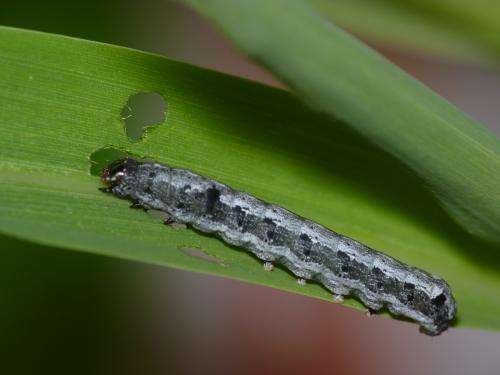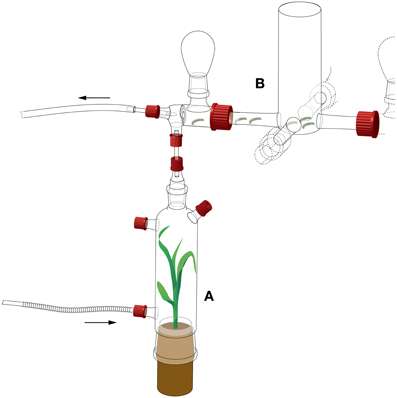Caterpillars attracted to plant SOS

Plants that emit an airborne distress signal in response to herbivory may actually attract more enemies, according to a new study published in the open-access journal Frontiers in Plant Science .
A team of researchers from Switzerland found that the odor released by maize plants under attack by insects attract not only parasitic wasps, which prey on herbivorous insects, but also caterpillars of the Egyptian cotton leafworm moth Spodoptera littoralis, a species that feeds on maize leaves.
When damaged, many plants release hydrocarbons called volatile organic compounds, similar to the compounds that cause the characteristic smell of freshly cut grass. These volatile organic compounds are known to be attractive to parasitoid wasps that lay their eggs inside other insects, killing them. Plants appear to use this strategy to fight back against herbivorous insects by calling for their enemies' enemies. In contrast, herbivorous insects tend to avoid the herbivore-induced volatile organic compounds.
"Adult moths and butterflies avoid food plants that are under attack by conspecifics. This seems adaptive, because it reduces both competition and the risk of predation by parasitoids. But we found that S. littoralis caterpillars are actually attracted to the odor of damaged maize plants, even when this odor is mimicked in the laboratory with a mix of synthetic compounds," said Prof. Ted Turlings, an author of the study and head of the Laboratory for Fundamental and Applied Research in Chemical Ecology Institute of Biology at the University of Neuchâtel, Switzerland.
To determine what kind of odors the caterpillars preferred, the researchers let the caterpillars chose among several odors by placing them in an olfactometer, a device consisting of four tubes connected to a central chamber, with each tube introducing an airflow carrying a different odor. The caterpillars were more than twice as likely to crawl towards the odor from maize plants under attack by conspecifics than towards undamaged plants, especially if the damage was recent and the caterpillars had already fed on maize.

So what might be the advantage to the caterpillars of moving towards plants that are already infested? "When S. littoralis caterpillars drop from a plant they are highly vulnerable to predators and pathogens in the soil, as well as to starvation. The advantage seems to be that fallen caterpillars can quickly rediscover the plant on which they fed. The caterpillars feed less and move more when exposed to high concentrations of the volatiles. By moving away from freshly damaged sites, they can minimize risk of predation and avoid competition," explained Prof. Turling.
Turlings and colleagues propose that hungry S. littoralis caterpillars do the best of a bad job by moving towards volatile organic compounds released by damaged maize plants. On these plants the competition may be more intense, but at least the caterpillars are assured of a suitable plant. Adult moths, on the other hand, are much more mobile and take little risk exploring the environment to discover the best food source—so they avoid maize that is already under attack.
More information: Herbivore-induced maize leaf volatiles affect attraction and feeding behaviour of Spodoptera littoralis caterpillars, Frontiers in Plant Science, DOI: doi: 10.3389/fpls.2013.00209
Provided by Frontiers



















